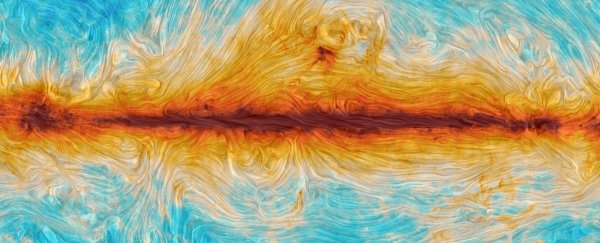A four-year survey of the entire sky has just delivered results, and they are awesome: we have confirmation that the standard cosmological model, which describes the age, rate of expansion, history and contents of the Universe, is indeed accurate.
For four years, the European Space Agency's Planck satellite sailed the skies, constantly scanning and collecting data so that we could study the radiation from the beginning of the Universe, across the entire sky.
Now, five years after that mission ended, the finalised data is in. It's as complete and accurate as it possibly can be.
The Planck satellite maps radiation in the microwave wavelength; this radiation was produced very shortly after the Big Bang, just 380,000 years into the existence of our Universe.
It's important because it's the earliest we can peer back in time. Prior to this point, the Universe had been completely dark and opaque - but when it cleared, electromagnetic radiation could move freely.
We call this map the cosmic microwave background (CMB); it was originally caused by photons, which became stretched into the microwave wavelength as the Universe expanded.
By studying differences and changes in the CMB across different regions of the sky, astronomers can calculate various characteristics of the Universe as it has evolved, over time. And this is what they did.
The first image of the CMB was published in 2013, corroborating the standard model of cosmology. Then, a second dataset, as well as analyses, came out in 2015. They contained both temperature and polarisation data - but there was a caveat.
Planck scientists felt that the quality of some of the polarisation data in that 2015 release - concerning the orientation of the light waves - was lacking, and was perhaps not good enough to be used for cosmology.
That brings us to this new release, called the legacy release. In the intervening years, the Planck consortium reprocessed the data, comparing it with observations made by other instruments, analyses and experiments. And they are pleased with the results.
"Now we really are confident that we can retrieve a cosmological model based on solely on temperature, solely on polarisation, and based on both temperature and polarisation," said cosmologist Reno Mandolesi of the University of Ferrara in Italy.
"And they all match."
The new data still supports the standard cosmological model, and is more accurate and reliable for scientists going forward.
This model is, the consortium believes, an excellent description of the Universe, including the structure and distribution of galaxies; the abundance of normal baryonic matter and cold dark matter; dark energy; and an inflation phase at the very beginning of the Universe.
It hasn't solved everything, though.
In fact, because the model is now more accurate, it presents an interesting conundrum: the Hubble Constant.
That's the name given to the rate of the expansion of the Universe. Recently, two telescopes in space teamed up, using Cepheid variable stars to determine the Hubble Constant with just 2 percent uncertainty.
They came up with 73.5 kilometres (45.6 miles) per second per megaparsec.
The problem is that, according to the Planck data, the Hubble Constant is 67.4 kilometres (41.9 miles) per second per megaparsec… with less than one percent uncertainty.
Because there's no single satisfactory astrophysical solution that can explain this discrepancy, this has led some to suggest that we need some sort of "new physics" to explain it. But it could be something more mundane, too.
"For the moment, we shouldn't get too excited about finding new physics: it could well be that the relatively small discrepancy can be explained by a combination of small errors and local effects," said Planck project scientist Jan Tauber of the ESA.
"But we need to keep improving our measurements and thinking about better ways to explain it."
One couldn't, actually, expect a better result from any data: confirmation of previous ideas, and some fascinating questions just begging for an answer.
If you're looking to do some science, or just poke around, the new data has been published free for use on the Planck Legacy Archive website.
Meanwhile, a series of papers describing the new results have been published on the ESA's website.
